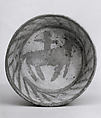Bowl
Not on view
This bowl has a flat base with a slight indentation, a low carinated shoulder, and a flaring rim. It is made of a pinkish buff clay, slightly burnished, with a pale cream slip. The clay is well-levigated and free of inclusions. The interior of the bowl is decorated, sometimes carelessly, with red paint. Parallel lines run along the rim and the interior of the shoulder, with a row of diagonal lines between them.
In the center of the bowl is an image of a rider, also in red paint. The horse’s legs are straight but pointed inward, suggesting the suspension phase of a gallop. The horse’s head and tail are indistinct, with both running into the painted decoration at the shoulder. The rider consists of a torso and a large head, with a longer arm extending toward the rear of the horse and a shorter arm toward the front. A thin curve, representing the bow, runs from the head through the longer arm and continues faintly on the other side. The bowl was apparently handled, and perhaps even spun, while the paint was still wet, resulting in a rather blurry appearance. But the overall impression is clearly one of a rider in full gallop aiming a bow at a target behind him, a maneuver known as the ‘Parthian shot.’
This type of pottery is generally known as ‘Ardabil Style’ after its supposed origin in northwestern Iran. Examples of it have been found at Yanik Tepe near Lake Urmia and at Coni in Azerbaijan, and these provide a general date range of ca. 400-100 B.C. for the Ardabil Style. Despite its name, the Parthian shot motif that appears on this bowl has a long history in this region, going back to the Urartians (ca. 900-600 B.C.). This shape of bowl is widely attested in the Achaemenid Empire, though it was also used in earlier and later periods, as a drinking vessel.
Due to rights restrictions, this image cannot be enlarged, viewed at full screen, or downloaded.

